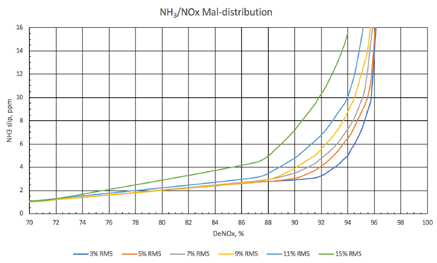Selective catalytic reduction (SCR) technology has been utilized for over 30 years within the power industry to treat NOX emissions. The technology utilizes a catalyst to initiate a reduction reaction utilizing ammonia (NH3), typically in an aqueous solution, to convert nitrous oxides to nitrogen (N2) and water (H2O).
The science behind this technology includes reactions that are typically involved with the reduction of nitrous oxides. These are made up of both nitrous oxide (NO) and nitrogen dioxide (NO2), are as follows:
4NO + 4NH3 + O2 ⟶ 2N2 + 3H2O
8NH3 + 6NO2 ⟶ 7N2 + 12H2O
These reactions are affected by operating temperature, oxygen, and ammonia levels. The temperature range in which these reactions are most prominent is 500 – 700˚F. Below this range, the speed of the reaction slows and other side reactions may become the predominant ones. Above this range, sintering of the catalyst can take place with irreversible effects on the effectiveness of the catalyst.
The oxygen level should typically be above 8% and below 15%. High oxygen levels can increase the formation of ammonia salts, while lower levels can decrease conversion efficiency. As can be seen in the reactions, there typically needs to be an equivalent amount of ammonia to that of nitrous oxide, and approximately 33% more for NO2.
Above or below these levels, the reduction reactions shown above may no longer be the predominant ones. Shifts in reaction speed may occur and side reactions may take place – all of which can lead to decreased efficiencies. In some cases, operating outside of these ranges can even result in the creation of NOX and ammonia salts. CO treatment follows a similar approach in that it also uses a catalyst but instead of reduction it employs oxidation to convert the CO to CO2. The primary reaction is as follows:
CO + ½ O2 ⟶ CO2
The CO catalyst uses a different set of substrates and precious metals, typically platinum or palladium, to initiate their reactions. Temperature is again very important for proper conversion and needs to be above 650˚F.
The reason there is an understanding to understand the science behind the technology comes back to emissions standards ad regulations. There are a few ways that these emissions are handled within the industry, but the elephant in the room is that these regulations are getting harder to meet. Not only are regulators looking for lower emissions, but newer combustion turbine technologies actually have higher levels of emissions, particularly NOX.
Therefore, ignoring an emissions control system is becoming harder to do, and incurs a greater cost. Today, plants should be more proactive regarding the servicing and monitoring of their emissions controls system. Improving these backend operations can have positive financial impacts on the overall operations, potentially resulting in hundreds of thousands of dollars in annual
operating profits.

Recent Comments